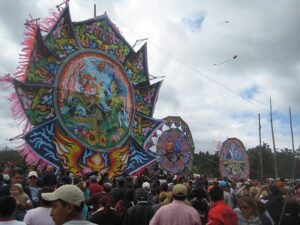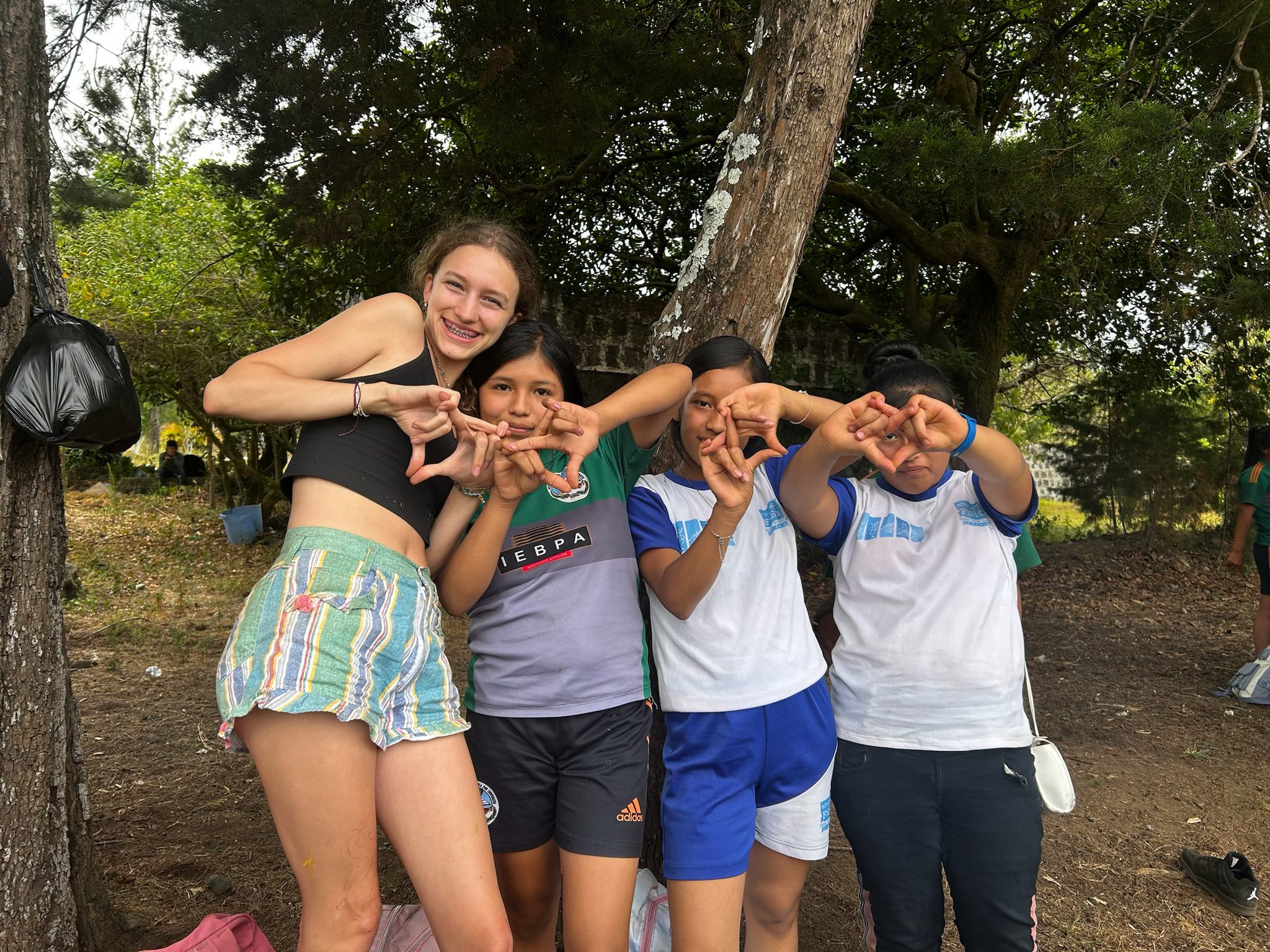As autumn winds sweep across Guatemala’s highlands, small kites begin to appear in the sky. Children run through streets with homemade creations. Meanwhile, vendors sell colorful tissue-paper kites on every corner. Families gather in open fields to practice their flying techniques.
This is kite season in Guatemala. It serves as a prelude to one of the country’s most spectacular cultural celebrations: Día de Todos Santos, or All Saints’ Day. Communities celebrate this holiday on November 1st.
While many North Americans prepare for Halloween with costumes and candy, Guatemalans ready themselves differently. They prepare for a profound holiday when the boundary between the living and the dead becomes permeable. Additionally, families reunite across generations. The sky transforms into a canvas for connection, remembrance, and hope.
A Celebration of Life, Not Fear
The contrast between Halloween and Día de Todos Santos reveals fundamental differences. These differences show how cultures approach death and remembrance. Halloween emphasizes ghosts, ghouls, and gore. It treats death as something frightening. Consequently, it becomes an occasion for playful scares and supernatural thrills.
In contrast, Guatemala celebrates differently. All Saints Day honors the lives of the saints. It also remembers those who have passed. Families give thanks for their lives. They celebrate their legacy. Rather than fear, Guatemalans approach this day with joy and reverence.
Families spend the day in the cemetery. They fly kites to communicate with deceased loved ones. They eat, dance, and sing between the tombs. Moreover, they cover the graves with flowers for the celebration. This affirms that death doesn’t sever family bonds. Love transcends the grave. One day each year, that connection becomes especially vivid.
The Legend of the Giant Kites
The tradition of the barriletes gigantes comes from a Sumpango legend. According to the story, bad spirits visit the cemetery every November 1st. These spirits haunt and disturb the resting souls there. Therefore, Sumpango inhabitants consulted their elders about this phenomenon. The elders offered a solution: force the bad spirits away through wind noise. Specifically, they recommended creating noise by letting wind touch pieces of paper.
Indigenous people have used kites for over 3,000 years. They use them to communicate and unite with deceased loved ones. According to the elders, the wind impact against the kites drives away bad spirits.
What began as spiritual protection evolved into breathtaking artistic expression. During the five months before November 1st, groups design their kites. Teams of young people work together. Families and entire communities dedicate themselves to creating these masterpieces. Furthermore, they keep their designs secret until festival day.

Art, Tradition, and Messages of Hope
These works of art measure up to 20 meters (65 feet) across. Artists construct them from bamboo, tissue paper, glue, and string. Each year features elaborate new designs. The largest kites remain on the ground for display. Their immense size makes flight impossible. However, their beauty remains profound.
These kites blend art, tradition, and colors. They convey messages of unity, love, and faith. Additionally, they express respect for traditions and Mother Nature. Modern designs often address contemporary issues. These include climate change, indigenous rights, and government corruption. They also tackle violence and social justice.
Recent kites have displayed powerful messages:
- “No more deaths of innocent lives in Guatemala”
- “Children of the ancestral culture”
- “Respect life is weaving peace”
- “We all deserve the same respect”
As a result, the kites become a form of collective voice. Communities express hope, demand change, and honor their heritage simultaneously.
The Festival Experience
On November 1st, Sumpango and Santiago Sacatepéquez transform completely. The towns become centers of celebration. Two categories of kites exist: flying kites and exhibition kites. The biggest ones measure 15 to 17 meters high. Their size and weight prevent them from flying.
Displaying these giant kites requires three tethers. Many people must help. During the festival, teams raise flying kites as high as possible. This entertains the crowd. According to legend, it also creates the loudest wind sound possible. Raising the kite symbolizes raising the creators’ dream. Keeping it high in the sky becomes their main goal.
The atmosphere pulses with energy. Traditional music fills the air. The smell of traditional foods wafts through crowds. Families dress in vibrant trajes (traditional Guatemalan clothing). Meanwhile, the sky fills with brilliant colors dancing against the November blue.
Fiambre: The Dish That Unites
No Guatemalan celebration would be complete without food. Día de Todos Santos features its own culinary tradition: fiambre.
This remarkable Guatemalan salad combines various ingredients. It features meats, cheeses, vegetables, and pickled delights. As a result, it creates a culinary tapestry that mirrors Guatemala’s cultural diversity. Each family guards their own recipe. They pass these recipes down through generations. Variations reflect regional traditions and personal preferences.
Families prepare fiambre to share in the cemetery. They share it with both the living and the dead. They set plates at gravesites as offerings to departed loved ones. Consequently, it becomes a meal that brings generations together both literally and symbolically.

Beyond the Kites: Honoring the Departed
The giant kite festival captures international attention. It draws thousands of tourists. However, quieter remembrances also take place. Throughout the country, families visit cemeteries. They lovingly clean and tend to gravesites. They adorn them with cut flowers and beautiful wreaths. These actions honor their loved ones.
Many believe the spirits of the deceased return on this day. They visit their living relatives. Families spend hours at gravesides. They share stories, prayers, and food. Sometimes they share music. This creates a festival atmosphere. It celebrates life rather than mourning death.
This approach offers a powerful alternative. Many cultures maintain sanitized distance from mortality. In contrast, Guatemala acknowledges death as part of life’s continuum. The departed remain integrated into family and community.
A Living Tradition for Modern Times
The tradition dates back to the pre-Colombian era. It existed before European influences arrived on the American continent. Over time, it evolved to incorporate Christian religious traditions. In 1999, Guatemala declared it part of the country’s cultural heritage.
The festival represents beautiful syncretism. It blends Mayan and Catholic traditions. Indigenous spiritual practices merge with Christian observances. Together, they create something uniquely Guatemalan. It demonstrates cultural resilience. It shows how traditions adapt and thrive even through centuries of colonization and change.

What Travelers Can Learn
For visitors experiencing Día de Todos Santos for the first time, the festival offers profound lessons. It teaches about cultural values, community, and our relationship with mortality:
Death as continuation, not ending: Guatemalan tradition maintains that relationships extend beyond physical death. This offers comfort and ongoing connection.
Community as creative force: The months-long collaborative process demonstrates collective power. Creating giant kites shows the strength of artistic expression.
Tradition as dynamic, not static: The festival honors ancient practices. Simultaneously, it addresses contemporary issues. This proves that tradition can be both rooted and relevant.
Celebration as remembrance: Joy and reverence aren’t opposites. They can coexist beautifully in honoring those we’ve lost.
Experiencing the Festival Respectfully
If you visit Guatemala during kite season and Día de Todos Santos, approach the experience with cultural humility:
First, recognize that you’re witnessing sacred traditions, not a tourist spectacle. Second, ask permission before photographing people, especially at gravesites. Third, purchase fiambre and kites from local vendors. This supports the community.
Additionally, learn about the kites’ messages and symbolism. Don’t just admire their beauty. Finally, consider hiring local guides. They can explain the deeper cultural significance.
Celebrating Life and Death
Each November 1st, magnificent kites rise above Guatemalan cemeteries. Their vibrant colors catch the highland wind. Their tissue paper rustles with the voices of the living and the dead. Consequently, they remind us that connection transcends all boundaries.
Halloween invites us to play with fear. In contrast, Día de Todos Santos invites us to celebrate love. It encourages us to honor memory. It helps us recognize that death doesn’t diminish our human bonds. In the swirling colors overhead and the families gathered below, Guatemala offers the world something valuable. It shows a different way of understanding life, death, and everything that connects them.
Interested in experiencing Guatemala’s living cultural traditions firsthand? Explore our Guatemala programs designed in partnership with local communities. You can participate in authentic cultural celebrations. Additionally, you’ll support grassroots organizations working on education and environmental conservation.



